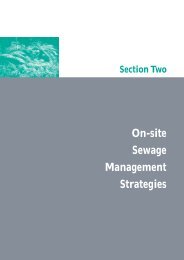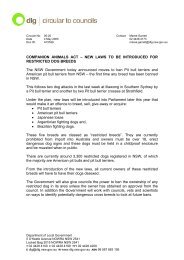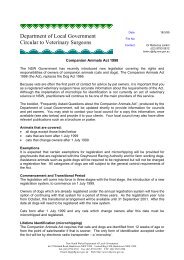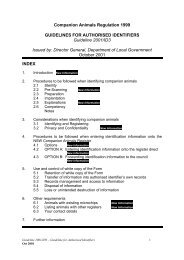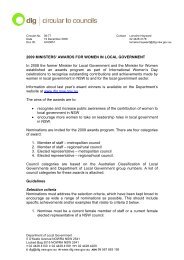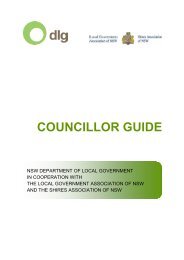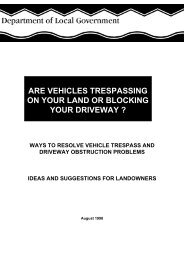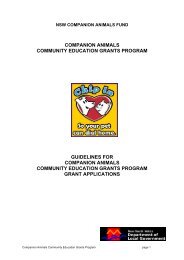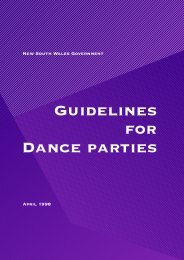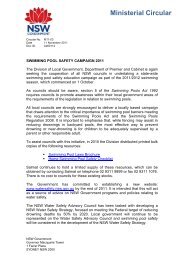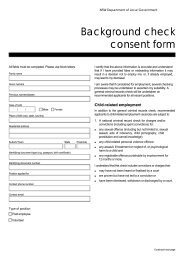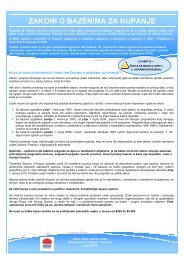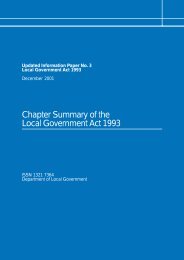Integrated Planning and Reporting Manual - Division of Local ...
Integrated Planning and Reporting Manual - Division of Local ...
Integrated Planning and Reporting Manual - Division of Local ...
You also want an ePaper? Increase the reach of your titles
YUMPU automatically turns print PDFs into web optimized ePapers that Google loves.
3. THE RESOURCING STRATEGY<br />
Developing an Asset Management Plan<br />
A major use for Asset Management Plan(s) is to communicate information about assets, including<br />
particular actions required to provide a defined level <strong>of</strong> service in the most cost-effective manner.<br />
For those councils that are yet to develop Asset Management Plan(s), they may wish to start <strong>of</strong>f the<br />
process by developing a ‘first cut’ plan based on existing data <strong>and</strong> documenting existing levels <strong>of</strong><br />
service, management strategy etc.<br />
While there are likely to be many gaps identified, <strong>and</strong> it may not serve all the council’s needs, this<br />
‘top down’ approach will provide a basis upon which the council can develop its Asset Management<br />
Strategy <strong>and</strong> ensures that some progress on asset planning is being made. The approach may be<br />
particularly attractive to smaller councils with limited financial <strong>and</strong> human resources.<br />
For many councils, the prospect <strong>of</strong> embarking on a comprehensive Asset Management <strong>Planning</strong><br />
process is overwhelming. A number <strong>of</strong> councils that are now well advanced in their Asset<br />
Management <strong>Planning</strong> have advised that this type <strong>of</strong> ‘one bite at a time’ approach made Asset<br />
Management <strong>Planning</strong> far less daunting. It also allowed them to gradually, <strong>and</strong> incrementally, build<br />
the knowledge <strong>and</strong> corporate support within their council.<br />
Another alternative is the ‘bottom up’ approach which starts <strong>of</strong>f the process by preparing the Asset<br />
Management Strategy, <strong>and</strong> through the Strategy improving the data <strong>and</strong> systems, <strong>and</strong> then<br />
preparing the Plan.<br />
The IIMM identifies the following advantages <strong>and</strong> disadvantages <strong>of</strong> each <strong>of</strong> these approaches 6 :<br />
Advantages<br />
Top Down Analysis (Core)<br />
Supports the 80/20 rule (get 80% <strong>of</strong> the results<br />
from the first 20% <strong>of</strong> effort)<br />
Identifies the weaknesses in the plan earlier <strong>and</strong><br />
focuses on appropriate data as opposed to<br />
perceived data needs<br />
Initially less resource intensive<br />
Better use <strong>of</strong> limited resources <strong>and</strong> quick results<br />
Bottom Up Analysis (Advanced)<br />
Outputs are data-driven with a high degree <strong>of</strong> confidence<br />
Data is <strong>of</strong> a high quality<br />
Ability to undertake data modelling <strong>and</strong> improve decision<br />
making<br />
Continuous plan revision is simpler<br />
Disadvantages Potential for compromised quality <strong>and</strong><br />
completeness <strong>of</strong> data<br />
Assumptions required to make decisions<br />
Potential for inappropriate decision making<br />
Inability to undertake detailed modelling <strong>and</strong><br />
sensitivity analysis<br />
Data collection takes time<br />
Time <strong>of</strong> production can impact on the ability to make<br />
urgent decisions<br />
Potential to lose focus on objectives – too focused on<br />
data issues<br />
Costly <strong>and</strong> time consuming<br />
Organisation can become data rich <strong>and</strong> information poor<br />
Lack <strong>of</strong> focus on supporting asset management activities<br />
When preparing the Asset Management Plan, it is important to gather all the relevant information<br />
which informs the planning process. This includes information about the condition <strong>of</strong> assets, risks<br />
<strong>and</strong> how they might be managed, <strong>and</strong> probable lifecycle costs.<br />
More detailed information on ‘core’ <strong>and</strong> ‘advanced’ asset management is discussed on page 4.6 <strong>of</strong><br />
the Australian Infrastructure Financial Management Guidelines – Version 1.0, 2009.<br />
6<br />
International Infrastructure Management <strong>Manual</strong>, page 2.41<br />
<strong>Planning</strong> & <strong>Reporting</strong> <strong>Manual</strong> Page 75 <strong>of</strong> 115



